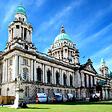NORTHERN IRELAND WAR MEMORIAL
Home Front Exhibition in Belfast
 In
all the stories of World War II, from the Blitz to Normandy, rarely
seen or told is the part of the north of Ireland. It was in Belfast where
the first American soldiers set foot overseas, many of them African American
troops. By war’s end over 300,000 Americans would be stationed
in the province. It was an American co-pilot, flying in a Catalina “flying-boat” from
the inland Lough Erne who first spotted the German battleship Bismark,
leading to its sinking. The Battle of the Atlantic, the longest sustained
campaign of the war, from September of 1939 to May of 1945 against the
Nazi U-Boats was fought from bases in the River Foyle of Londonderry,
with escort ships.
In
all the stories of World War II, from the Blitz to Normandy, rarely
seen or told is the part of the north of Ireland. It was in Belfast where
the first American soldiers set foot overseas, many of them African American
troops. By war’s end over 300,000 Americans would be stationed
in the province. It was an American co-pilot, flying in a Catalina “flying-boat” from
the inland Lough Erne who first spotted the German battleship Bismark,
leading to its sinking. The Battle of the Atlantic, the longest sustained
campaign of the war, from September of 1939 to May of 1945 against the
Nazi U-Boats was fought from bases in the River Foyle of Londonderry,
with escort ships.
 In Belfast, on the night of Easter, April 15, 1941, the most deadly
Blitz bombing of the British Isles outside London fell on the working
class section of the city, killing 745. In May of 1944, a massive armada
of American ships was assembled in the mouth of Belfast Bay to escort
the transporters carrying the United States divisions to beaches of Northern
France. The shipyards of Harland and Wolff, where the Titanic was built
(see Titanic Belfast), built 140 warships and 123 merchant vessels for
the war. Eighty Thousand men and women from Ireland, both North and the
Republic, all volunteers, served in the British Army, Royal Navy and
Royal Air Force, in every theater of the war. Of the American troops
based in the small towns and villages, training for the battles in North
Africa and Europe, many Ulster girls became GI war brides, and tens of
thousands of local Irish served in the Ulster Home Guard and Auxiliary
Fire Service.
In Belfast, on the night of Easter, April 15, 1941, the most deadly
Blitz bombing of the British Isles outside London fell on the working
class section of the city, killing 745. In May of 1944, a massive armada
of American ships was assembled in the mouth of Belfast Bay to escort
the transporters carrying the United States divisions to beaches of Northern
France. The shipyards of Harland and Wolff, where the Titanic was built
(see Titanic Belfast), built 140 warships and 123 merchant vessels for
the war. Eighty Thousand men and women from Ireland, both North and the
Republic, all volunteers, served in the British Army, Royal Navy and
Royal Air Force, in every theater of the war. Of the American troops
based in the small towns and villages, training for the battles in North
Africa and Europe, many Ulster girls became GI war brides, and tens of
thousands of local Irish served in the Ulster Home Guard and Auxiliary
Fire Service.
 At
the end of the war, the Northern Ireland government decided that a
memorial building, rather than a single monument stature should be
built in one of the sites devastated by the Blitz bombing of Belfast.
The site has moved at least once, but The Northern Ireland War Memorial
and Homefront Exhibition is now found on Talbot Street, just across from
St Anne Cathedral and a short walk from the City Hall and Queens Bridge.
The story of Northern Ireland’s part in the world war is told through
tableaux of figures, rolls of participants in interactive form, with
books of Remembrance Records. The Memorial
Wall is lined with highly polished black marble from Belgium. Copper
friezes by James McKendry honor the
presence of the United States forces in Northern Ireland and war effort
of Ulster’s men and women on the Home Front.
At
the end of the war, the Northern Ireland government decided that a
memorial building, rather than a single monument stature should be
built in one of the sites devastated by the Blitz bombing of Belfast.
The site has moved at least once, but The Northern Ireland War Memorial
and Homefront Exhibition is now found on Talbot Street, just across from
St Anne Cathedral and a short walk from the City Hall and Queens Bridge.
The story of Northern Ireland’s part in the world war is told through
tableaux of figures, rolls of participants in interactive form, with
books of Remembrance Records. The Memorial
Wall is lined with highly polished black marble from Belgium. Copper
friezes by James McKendry honor the
presence of the United States forces in Northern Ireland and war effort
of Ulster’s men and women on the Home Front.
Visiting the War Memorial in Belfast
 The
NI War Memorial is open Monday to Friday 10:30 am to 4:30 pm. Entrance
to the memorial exhibit is free. No need for an audio guide as a real
living volunteer docent and war veteran will usually be on duty to explain
the exhibits and history from one who’s lived it. For a bit of
actual war exhibits, head out to the Titanic Pump House & Drydock
(see Titanic
Drydock),
for a look at the HMS Caroline, one of the last surviving WWI era war
ships from 1914 and participant in the Atlantic Battle, now finally open for visitors (see HMS Caroline WW1 Cruiser). © Bargain
Travel Europe
The
NI War Memorial is open Monday to Friday 10:30 am to 4:30 pm. Entrance
to the memorial exhibit is free. No need for an audio guide as a real
living volunteer docent and war veteran will usually be on duty to explain
the exhibits and history from one who’s lived it. For a bit of
actual war exhibits, head out to the Titanic Pump House & Drydock
(see Titanic
Drydock),
for a look at the HMS Caroline, one of the last surviving WWI era war
ships from 1914 and participant in the Atlantic Battle, now finally open for visitors (see HMS Caroline WW1 Cruiser). © Bargain
Travel Europe
Find best travel deals in Northern Ireland on TripAdvisor
Web
Info
NI
War Memorial
These articles are copyrighted and the sole property of Bargain Travel Europe and WLPV, LLC. and may not be copied or reprinted without permission.
SEE ALSO:
ARMAGH PUBLIC LIBRARY & VICAR’S HILL No 5
NOMADIC BELFAST - TENDER TO TITANIC

